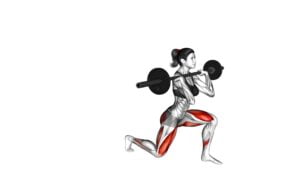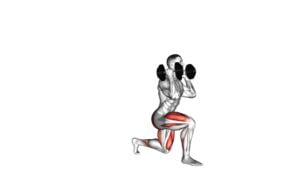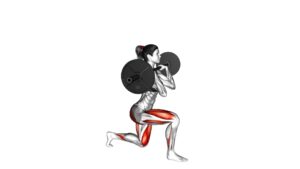Barbell Front Rack Lunge – Video Exercise Guide & Tips

Are you looking to strengthen your lower body and improve your overall fitness? Then the Barbell Front Rack Lunge is the exercise for you.
Watch This Exercise Video
This video exercise guide and tips will show you the proper form and technique to perform this challenging movement. Avoid common mistakes and learn variations and progressions to keep challenging yourself.
With these tips, you'll be on your way to maximizing your results and achieving your fitness goals.
Let's get started!
Key Takeaways
- Barbell Front Rack Lunge strengthens lower body and improves overall fitness.
- It targets multiple muscle groups simultaneously including quadriceps, hamstrings, glutes, and calves.
- The exercise enhances core strength, balance, and stability.
- There are different lunge variations that can be incorporated for variety.
Benefits of Barbell Front Rack Lunge
The barbell front rack lunge offers numerous benefits for your lower body strength and stability. Incorporating this exercise into your workout routine can help you build strong and powerful legs. One of the key benefits of the barbell front rack lunge is its ability to target multiple muscle groups simultaneously. As you perform the lunge, your quadriceps, hamstrings, glutes, and calves are all engaged, resulting in a comprehensive lower body workout.
Moreover, the front rack position of the barbell places additional emphasis on your core, forcing it to work harder to stabilize your body. This not only improves your core strength but also enhances your overall balance and stability.
Another advantage of the barbell front rack lunge is its versatility. There are various lunge variations that you can incorporate to target different muscles or add variety to your routine. For example, you can perform walking lunges, reverse lunges, or lateral lunges to challenge your lower body from different angles. This variety not only keeps your workouts interesting but also ensures that you're working your muscles in different ways, leading to better overall development.
Transitioning into the subsequent section about equipment and set-up, it's important to note that the barbell front rack lunge requires some specific equipment and set-up to be performed correctly and safely.
Equipment and Set-Up
To properly perform the barbell front rack lunge, you'll need specific equipment and set-up.
First and foremost, you'll require a barbell with weight plates. The weight plates should be appropriate for your fitness level and goals.
You'll also need a squat rack or a rig to hold the barbell securely. Make sure the rack is set at a height that allows you to comfortably unrack and re-rack the bar.
Additionally, you'll need a safety mechanism, such as spotter arms or safety pins, to prevent accidents or injuries during the exercise.
To set up for the barbell front rack lunge, begin by positioning the barbell at shoulder height on the rack. Stand facing the bar and grip it with your hands slightly wider than shoulder-width apart. Make sure your elbows are pointing forward and your upper arms are parallel to the ground. This is the proper form for the front rack position.
To demonstrate proper form, start by stepping forward with one leg, keeping your torso upright and your core engaged. Lower your body until your front thigh is parallel to the ground, making sure your knee doesn't extend past your toes. Push through your front heel to return to the starting position and repeat with the other leg.
Proper Form and Technique
To perform the barbell front rack lunge with proper form and technique, ensure that you maintain a stable core and engage your glutes throughout the exercise. This will help you maximize the benefits of the exercise and prevent any potential injuries.
Common mistakes to avoid include allowing your knees to cave inwards, leaning too far forward or backward, and not fully extending your front leg. When your knees cave in, it puts unnecessary stress on your joints and can lead to knee pain or injury. Leaning too far forward or backward can compromise your balance and stability, increasing the risk of falling or straining your back. Failing to fully extend your front leg can limit the effectiveness of the exercise and place excessive strain on your knee.
To prevent injuries, it's important to focus on maintaining proper posture throughout the movement. Keep your chest lifted, shoulders back, and core engaged. This will help distribute the weight evenly and protect your spine. Additionally, make sure you use a weight that's appropriate for your strength level to avoid overloading your muscles and joints.
Common Mistakes to Avoid
To perform the barbell front rack lunge with proper form, it's important to avoid common mistakes that can hinder your progress and increase the risk of injury.
One common mistake is allowing your knees to cave inwards during the lunge, which puts unnecessary stress on the joints.
Another mistake to avoid is leaning too far forward, as this can strain your lower back.
Proper Form Demonstration
Avoid the common mistakes in the proper form demonstration of the Barbell Front Rack Lunge. Here are some tips to help you perform this exercise correctly:
- Keep your torso upright: Maintaining an upright posture is essential for targeting the correct muscles and preventing strain on your back.
- Step forward with control: Avoid rushing through the movement and ensure that each step is deliberate and controlled.
- Maintain proper knee alignment: Keep your front knee aligned with your ankle and avoid letting it collapse inward.
- Engage your core: Activate your core muscles throughout the exercise to provide stability and support for your spine.
By following these tips, you can maximize the benefits of the barbell front rack lunge and reduce the risk of injury.
Remember to also explore different variations of this exercise to keep challenging your muscles and prevent plateaus in your fitness routine.
Injury Prevention Tips
Maintain proper form and avoid common mistakes to prevent injuries while performing the barbell front rack lunge. Injury prevention strategies are crucial to ensure a safe and effective workout.
Before starting your lunges, it's important to warm up properly to prepare your muscles and joints for the exercise. Engaging in dynamic warm-up exercises, such as leg swings or walking lunges, can help increase blood flow, improve flexibility, and reduce the risk of injury.
Additionally, it's essential to maintain proper posture throughout the lunge movement. Keep your chest up, shoulders back, and core engaged to prevent excessive stress on your lower back and knees.
By following these injury prevention tips, you can safely perform the barbell front rack lunge and maximize your results.
Now, let's explore some variations and progressions of this exercise.
Variations and Progressions
For more challenging variations and progressions of the barbell front rack lunge, you can incorporate different weights and movement patterns. Here are some ideas to take your lunges to the next level:
- Lunges with Dumbbells: Instead of using a barbell, hold a pair of dumbbells in each hand. This will challenge your core stability and allow for a greater range of motion.
- Single Leg Barbell Lunges: Once you have mastered the basic barbell front rack lunge, try performing the exercise on one leg. This variation increases the demand on your stabilizing muscles and improves balance.
- Walking Lunges: Instead of lunging in place, take a step forward with each repetition. This adds a dynamic element to the exercise and engages more muscles in your lower body.
- Reverse Lunges: Instead of stepping forward, step backward into the lunge position. This variation targets your glutes and hamstrings more effectively.
Remember to start with lighter weights and gradually increase the load as you become more comfortable and proficient with each variation. Focus on maintaining proper form and control throughout each movement.
Tips for Maximizing Results
To maximize your results with the barbell front rack lunge, it's crucial to focus on proper form. This means maintaining an upright posture, keeping your core engaged, and ensuring your knee stays in line with your toes.
Additionally, varying your lunge variations, such as using dumbbells or performing walking lunges, can help target different muscles and prevent plateaus.
Lastly, consistency is key – aim to perform the exercise regularly and gradually increase the weight or intensity to continually challenge your muscles and see progress.
Proper Form Importance
Get the most out of your barbell front rack lunges by focusing on proper form throughout the exercise. Proper form benefits include maximizing results and reducing the risk of injury. Here are some tips to help you maintain proper form:
- Keep your core engaged: By bracing your core, you stabilize your spine and maintain balance during the exercise.
- Maintain an upright torso: Avoid leaning forward or rounding your back. This ensures that your legs are doing the work and prevents strain on your lower back.
- Step forward with control: Take deliberate steps and avoid rushing through the movement to maintain stability and control.
- Keep your knee in line with your toes: This helps to protect your knee joint and ensures proper alignment.
By following these tips, you can perform barbell front rack lunges with proper form, maximizing your results and reducing the risk of injury.
Now, let's explore the next section on varying lunge variations.
Varying Lunge Variations
Try incorporating different variations of lunges to maximize your results. Lunges are a versatile exercise that targets multiple muscle groups, improves balance, and enhances overall lower body strength. Adding variety to your lunge routine can help prevent plateaus and keep your workouts challenging and effective.
Advanced lunges, such as walking lunges, reverse lunges, and lateral lunges, take the basic lunge to the next level by adding different movement patterns and engaging different muscles. Walking lunges, for example, require you to move forward while performing the lunge motion, increasing the cardio aspect of the exercise. Reverse lunges target the glutes and hamstrings more intensely, while lateral lunges work the inner and outer thighs.
Consistency for Best Results
To maximize your results, it's important to maintain consistency in your lunge routine. Here are some tips for consistency and tracking progress:
- Set a schedule: Plan your lunge workouts in advance and stick to a regular routine. Consistency is key, so aim for a certain number of sessions per week and stay committed.
- Keep a workout log: Track your progress by recording the number of sets, reps, and weights used for each lunge variation. This will help you see improvements over time and stay motivated.
- Gradually increase intensity: As you get stronger, challenge yourself by adding more weight or increasing the difficulty of your lunge variations. Progressively pushing your limits will lead to better results.
- Stay accountable: Find a workout buddy or join a fitness community to hold you accountable. Having support and encouragement can help you stay consistent and motivated in your lunge routine.
Frequently Asked Questions
How Many Sets and Repetitions Should I Do for the Barbell Front Rack Lunge?
For the barbell front rack lunge, it's important to find the optimal weight and maintain proper form.
As for sets and repetitions, it depends on your fitness goals. To build strength, aim for 3-5 sets of 8-12 repetitions with a challenging weight.
If you're focusing on endurance, go for higher reps with lighter weights.
To add more challenge, you can try variations like walking lunges or reverse lunges.
Always listen to your body and adjust as needed.
Can the Barbell Front Rack Lunge Help Improve My Balance and Stability?
Improving your balance and stability is one of the benefits of the barbell front rack lunge. This exercise requires you to engage your core and stabilize your body while performing the movement.
Is the Barbell Front Rack Lunge Suitable for Beginners or Is It More Advanced?
The barbell front rack lunge can be suitable for beginners or more advanced individuals, depending on modifications made. It's a challenging exercise that improves balance and stability while targeting the lower body muscles.
Beginners can start with lighter weights or use dumbbells instead of a barbell. As you progress, you can increase the weight and intensity.
Incorporating the barbell front rack lunge into your workout routine can provide numerous benefits, such as increased leg strength and improved core stability.
Can the Barbell Front Rack Lunge Help With Strengthening the Core Muscles?
Yes, the barbell front rack lunge is a great exercise for improving core strength. By engaging your core muscles to maintain stability during the movement, you're effectively strengthening your abdominal muscles, obliques, and lower back.
This exercise provides numerous benefits, such as enhancing overall balance and stability, improving posture, and increasing functional strength.
Incorporating the barbell front rack lunge into your workout routine can help you achieve a stronger and more stable core.
What Muscles Are Targeted When Performing the Barbell Front Rack Lunge?
When performing the barbell front rack lunge, you target multiple muscles in your lower body, including your quadriceps, hamstrings, glutes, and calves.
This exercise also engages your core muscles, helping to strengthen and stabilize your midsection.
By incorporating barbell front rack lunges into your leg day routine, you can experience several benefits, such as increased leg strength, improved balance, and enhanced overall athleticism.
To ensure proper form and technique, keep your chest up, step forward, and lower your back knee towards the ground.
Conclusion
In conclusion, the barbell front rack lunge is a highly effective exercise for building strength, stability, and mobility in the lower body. By properly setting up the equipment and maintaining proper form and technique, you can maximize the benefits of this exercise.
Avoiding common mistakes and progressing through variations will help you continue to challenge your muscles and see progress over time. Remember to always prioritize proper form and listen to your body to achieve the best results.

Author
Years ago, the spark of my life’s passion ignited in my mind the moment I stepped into the local gym for the first time. The inaugural bead of perspiration, the initial endeavor, the very first surge of endorphins, and a sense of pride that washed over me post-workout marked the beginning of my deep-seated interest in strength sports, fitness, and sports nutrition. This very curiosity blossomed rapidly into a profound fascination, propelling me to earn a Master’s degree in Physical Education from the Academy of Physical Education in Krakow, followed by a Sports Manager diploma from the Jagiellonian University. My journey of growth led me to gain more specialized qualifications, such as being a certified personal trainer with a focus on sports dietetics, a lifeguard, and an instructor for wellness and corrective gymnastics. Theoretical knowledge paired seamlessly with practical experience, reinforcing my belief that the transformation of individuals under my guidance was also a reflection of my personal growth. This belief holds true even today. Each day, I strive to push the boundaries and explore new realms. These realms gently elevate me to greater heights. The unique combination of passion for my field and the continuous quest for growth fuels my drive to break new ground.







